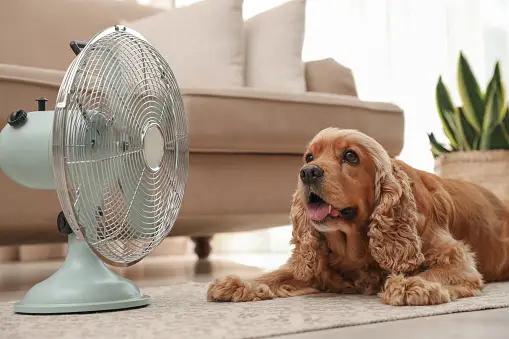
25 May Signs Your Dog Is Suffering From Heat Exhaustion and How To Help
Humans And Pets Love Summer
Summertime brings warmth, sunshine, and longer days, making it a favorite season for many. It’s a time when we can enjoy outdoor activities, soak up the sun, and create lasting memories. However, as the temperature rises, it becomes essential to pay special attention to the well-being of our beloved pets. Just as we take precautions to protect ourselves from the heat, our furry friends also require extra care during this time of the year. Dogs are susceptible to heat-related illnesses, and it’s crucial to know the signs of heat exhaustion and how to provide immediate help. No matter where you live, this is good information to know. Pets suffering from heat exhaustion is one of the more common cases animal urgent care and emergency care facilities encounter. When your animal is suffering from heat exhaustion it is important to know that it is always an emergency and you need to get them seen ASAP. Let’s take the time to discuss the various signs that indicate your dog is suffering from heat exhaustion and provide you with actionable steps to assist them.

Panting and Excessive Drooling
One of the initial signs that your dog may be suffering from heat exhaustion is excessive panting and drooling. Dogs regulate their body temperature through panting, but when the heat becomes overwhelming, panting intensifies. If you notice your dog excessively panting or drooling, it’s a clear indication that they are struggling to cool down.
It’s important to note that brachycephalic breeds (such as Bulldogs and Pugs) are more susceptible to heat exhaustion due to their shortened airways. If you own a brachycephalic dog, it’s crucial to be extra vigilant in monitoring its heat exposure.
Lethargy and Weakness
When dogs are exposed to excessive heat, they may exhibit signs of lethargy and weakness. If you observe your usually energetic pup becoming sluggish or unwilling to participate in activities, it could be a symptom of heat exhaustion. Dogs suffering from heat-related illnesses often have difficulty standing or may even collapse.
Rapid Heart Rate and Heavy Breathing
Heat exhaustion causes an increase in a dog’s heart rate and breathing rate. If you notice your dog’s heart beating rapidly or their breaths becoming more labored, it’s a clear indication that they are experiencing heat-related distress. Pay attention to any abnormal respiratory patterns as they can be a sign of severe heat exhaustion. It is imperative that you treat this situation as an emergency and get them to an animal urgent care immediately.
Bright Red or Pale Gums
Inspecting your dog’s gums is a reliable way to determine their overall health. In the case of heat exhaustion, their gums may appear bright red or even pale. Heat-related illnesses affect blood circulation, leading to changes in gum color. Healthy gums should have a pinkish hue so that any drastic changes can be a cause for concern.
Vomiting and Diarrhea
Heat exhaustion can lead to gastrointestinal distress in dogs, resulting in vomiting and diarrhea. If your dog shows signs of stomach upset, it could be a consequence of heat-related illness. Keep an eye on their bowel movements and consult a veterinarian if the symptoms persist.
Dizziness and Disorientation
Heat exhaustion affects a dog’s neurological function, leading to symptoms such as dizziness and disorientation. If your dog appears confused, struggles to maintain balance, or seems unaware of their surroundings, taking immediate action is crucial.
Seizures and Collapse
In severe cases of heat exhaustion, dogs may experience seizures or collapse. These are alarming signs that require urgent medical attention. If your dog loses consciousness, convulses, or has a seizure, it’s crucial to seek professional help without delay.
How to Help Your Dog
Now that we’ve discussed the signs of heat exhaustion in dogs let’s explore the steps you can take to help your furry companion when they are experiencing heat-related distress.
Move to a Cool Environment
If you suspect your dog is suffering from heat exhaustion, immediately move them to a cool, shaded area. Bring them indoors if possible, or find a spot with good ventilation. It’s essential to remove them from the heat source and allow their body temperature to regulate.
Provide Fresh Water
Ensure that your dog has access to fresh and cool water at all times. Encourage them to drink, but do not force it. Avoid using ice-cold water, as it may cause their body temperature to drop rapidly, which can have adverse effects.
Wet Towel or Cooling Mat
You can help your dog cool down by using a wet towel or a cooling mat. Wet the towel with cool water (not cold) and place it over their body, focusing on their head, neck, and paw pads. Cooling mats are designed to lower body temperature and can provide relief for your overheated pup.
Use Fans or Air Conditioning
Utilize fans or air conditioning to create a cool and comfortable environment for your dog. Circulating air can aid in regulating their body temperature. If you don’t have air conditioning, place a fan in the room or direct it towards your dog’s resting area.
Avoid Excessive Cooling
While it’s essential to help your dog cool down, avoid using ice or very cold water directly on them. Rapid cooling can lead to shock or other complications. Gradual cooling is safer and more effective in treating heat exhaustion.
Contact Animal Urgent Care
Note that all of these steps are important to do immediately. However, it does not replace contacting your local urgent care to seek medical attention. Animals experiencing heat exhaustion can quickly turn into an emergency so it’s always best to seek medical care for your dog if they are exhibiting the symptoms listed above.
FAQs
Q1: Can I leave my dog in the car for a few minutes during hot weather?
A: No, leaving your dog in the car is never safe during hot weather. Even with the windows cracked, temperatures inside a car can quickly reach dangerous levels, putting your dog at risk of heat exhaustion or even death.
Q2: How can I prevent heat exhaustion in my dog?
A: To prevent heat exhaustion, ensure that your dog always has access to shade, fresh water, and a cool environment. Avoid exercising them during the hottest parts of the day and be mindful of their breed’s susceptibility to heat-related illnesses.
Q3: Can shaving my dog’s fur help prevent heat exhaustion?
A: Contrary to popular belief, shaving your dog’s fur very short is not always beneficial in preventing heat exhaustion. A dog’s coat acts as insulation and protects them from both heat and cold. Consult with a professional groomer or veterinarian to determine the best grooming approach for your dog’s breed and climate.
Q4: Are certain dog breeds more prone to heat exhaustion?
A: Yes, brachycephalic breeds, such as Bulldogs, Pugs, and Boxers, are more susceptible to heat-related illnesses due to their shortened airways. Dogs with thick coats or underlying health conditions may also be at higher risk.
Q5: Can I use sunscreen on my dog to protect them from the sun?
A: While sunscreen is generally safe for humans, it is not recommended for dogs unless specifically formulated for canine use. Some human sunscreens contain ingredients that can be toxic to dogs. Consult with your veterinarian to find a dog-friendly sunscreen if your dog requires sun protection.
Q6: How long does it take for a dog to recover from heat exhaustion?
A: The recovery time for heat exhaustion varies depending on the severity of the condition. Mild cases can resolve within a few hours with proper care, while severe cases may require several days of monitoring and veterinary treatment.
Let’s Be Vigilant
Yes, summer is here, and we all love the fun, energy, and life it brings, but we have to be careful with the heat accompanying it as well. Recognizing the signs of heat exhaustion in dogs is crucial for their well-being. By being aware of the symptoms and taking immediate action, you can help your dog recover from heat-related distress. Remember to provide a cool environment, freshwater, and seek veterinary assistance if necessary. Stay vigilant, keep your furry friend safe, and enjoy the summer months together!



